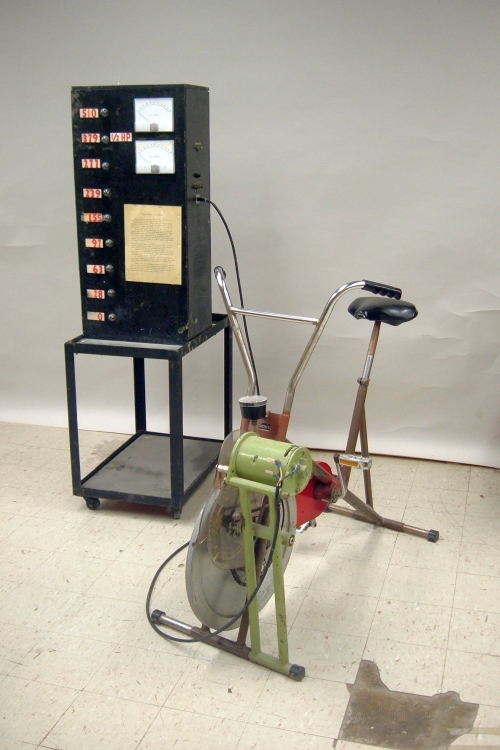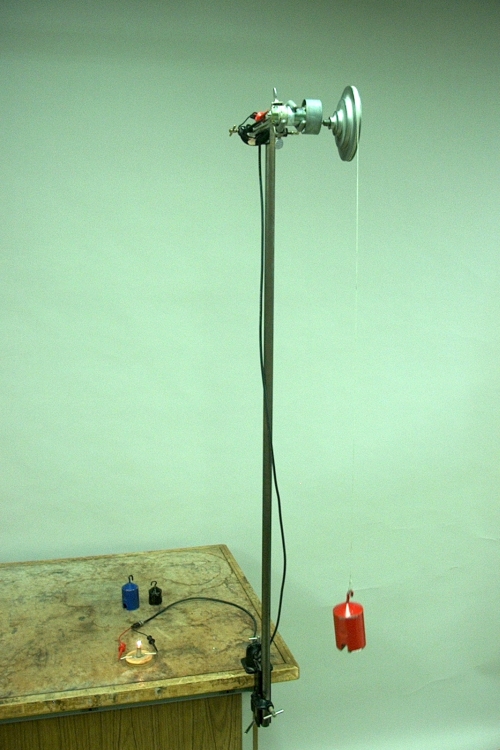 |
|
 |
|
||
 |
|
 |
|
||
You can disconnect each of these generators from its load to show the dramatic difference in effort required to turn the generator when the load is not connected, compared to when it is connected.
The bicycle generator is also listed as 52.39, and the motor with the falling weight is also listed as 52.36, both under “Energy Conversion.”
The pages for demonstrations 52.36 -- Falling weight generator, and 72.12 -- AC/DC generator, describe in detail how generators convert mechanical energy (or work) into electrical energy (or work). As one turns the shaft of the generator, it turns a set of armature coils that sit within the magnetic field of a set of permanent magnets. The changing magnetic flux through the coils as they turn, induces an EMF in them, which, if a load is connected across the coils, causes a current to flow through them and the load. The current in the armature coils produces a magnetic field that opposes the field of the permanent magnets, which causes repulsion of the coils from the magnets in one direction, and attraction in the opposite direction, and thus a torque that opposes the external torque applied to the shaft of the generator. (See demonstration 72.09 – Lenz’s law. Below, for simplicity, we will refer to this as “magnetic repulsion.”) As a result, the effort required to turn the generator shaft is much greater when a load is connected to it, than it is when there is no load connected. Also, with a load connected, the faster one tries to turn the generator, the greater the effort it requires to do so.
Bicycle generator
The bicycle generator shown above at left, is connected to a box that contains a (resistive) load, and a circuit that switches on the indicator lamps according to how much power is being dissipated in the load (and the lamps). On the front face of the box are a large voltmeter and a large ammeter. As the rider pedals, these read the voltage across the load and lamps, and the current through them. The power dissipated in the load and lamps is the product of the voltage and the current, or VI, for which the units are [(N·m)/C](C/s), or J/s. One joule/s equals one watt (W), which is the unit for the numbers next to the lamps. That is, starting from zero, as one increases the pedaling effort, the lights indicate output of just above 0 W, then 28 W, then 63 W, etc., up to 510 W, above which the lamp on top of the box lights. Next to the lamp that indicates an output of 379 watts is a label that reads “1/2 HP,” for “1/2 horsepower.” In the 1770s, James Watt established the unit of the horsepower (hp) as the power required to pull a 150-pound weight out of a 220-foot-deep well in one minute. (He had invented a steam engine, which he intended to sell. Since his engine would replace the horses that his potential customers used, he thought it prudent to rate its power output relative to that of a horse. See https://spark.iop.org/why-one-horsepower-more-power-one-horse.) This works out to 33,000 foot-pounds per minute, or 550 foot-pounds per second. If we convert foot-pounds to newton-meters (joules), we find that this equals 746 W. One-half horsepower, then, is 746/2 = 373 W. Hence the “1/2 HP” label at the lamp that corresponds to a power output of 379 W, which is close to this value.
If you have a student sit on the bicycle, with the switch off (so that the load is disconnected), the student finds it easy to turn the pedals. If you now flip the switch to connect the load (after warning the student and confirming that the student is ready), the student now feels significant resistance; the faster the student is pedaling, the greater the resistance. This is because with the load disconnected, the only work the student is doing is the work necessary to spin the flywheel of the bicycle and turn the unloaded generator. Though the flywheel is somewhat massive, and the gear ratio from the wheel to the generator is rather high, it is not difficult to spin them. When the load is connected, by turning the pedals the student is now driving current through the load, and thus doing work and producing power. The faster the student tries to pedal, the greater the work the student does per unit time, and the greater the power the student produces. As noted above, while the student pedals with the load connected, the meters and lamps indicate the voltage, current and power the student is producing at a given instant.
If, with the load connected, the student pedaled at a constant rate for a specific time interval, then the total energy expended by the student, or the work done, would be the power output multiplied by the number of seconds in the time interval. If the student pedaled at a varying rate, then the total energy expended, or work done, would be the integral of the power at each instant over the time interval of interest. In all of this, we are ignoring the fact that the efficiency of the generator is not 100%.
Falling weight generator
Shown above at right, is a DC motor with a reducing gear box, to whose output shaft is attached a stepped wheel. Attached to the largest-diameter step on the wheel is a six-foot string with a loop at the free end, from which you can hang a mass. The terminals of the motor are connected to a 6.3-volt (#47) miniature lamp. If the string is not already wound around the wheel, wind it around the wheel, and turn the wheel so that the loop just touches it. Hang the 1-kg mass (shown) from the loop, and release it. The lamp lights brightly as the mass descends. If as the mass is descending, you disconnect one of the clips from the lamp, the mass suddenly and greatly accelerates. You can also hang either of the other masses shown (200 g and 500 g), to compare how they fall, and how brightly they light the lamp as they do so. Please do not yank on the string or jerk the wheel. This will produce excessive current, which will burn out the lamp.
With the load (the miniature lamp) connected, as the mass falls, the aforementioned magnetic repulsion balances the force of gravity on the hanging mass, so that the tension in the string equals this force, and the mass descends at a constant velocity. How much current is produced at a particular speed depends on the size of the load. The larger the load (the smaller its resistance), the greater the current flow for a particular EMF (which is proportional to the speed at which the generator shaft rotates). The speed at which the mass falls depends on how much current is necessary to produce a strong enough magnetic field that the magnetic repulsion balances gravity, which in turn depends on the mass, m. The greater the mass, the greater the speed at which it falls. As the resistance of the load increases, the speed at which a given mass must descend to generate enough current for the repulsion to balance gravity, increases. If we disconnect the load (resistance goes to infinity), then no current can flow, there is no magnetic repulsion, the mass accelerates. The mass would be in free fall, except that friction and rotational inertia in the generator and gear box cause its acceleration to be less than g.
If you hang the 200-g mass from the wheel, it falls slowly, but does not light the lamp. If you hang the 500-g mass, it falls faster than the 200-g mass, and it lights the lamp dimly. If you hang the 1-kg mass, it falls faster than both of the other masses, and it lights the lamp brightly. In all three cases, of course, if you disconnect the lamp (the load), the mass suddenly accelerates greatly.
Ideally, this generator should produce a quantity of electrical energy equivalent to the change in gravitational potential energy of the mass over the distance through which it falls. This quantity is reduced, of course, by however much the efficiency of the generator is less than 100%. With the 1-kg mass at the end of the string, the generator produces a current of about 140 mA through the lamp at about 5.3 V, which corresponds to a power of about 0.74 watts. If the mass is released so that it falls the entire length of the string, it takes approximately 8.8 seconds to do so. This corresponds to a total energy output of (0.74 W)(8.8 s) = 6.5 J. The length of the string is six feet, or about 138 cm. The change in potential energy of the 1-kg mass during its descent is thus (1.0 kg)(9.8 m/s2)(0.183 m) = 18 J. This corresponds to an efficiency of about 36%. This is probably reasonable, since it is quite likely that the lamp and generator are not matched, and we are not operating the generator at its maximum efficiency.
Hand-cranked generator
Shown in the center, below the bicycle generator and falling weight generator, is a small generator that one cranks by hand. For ease of operation, the base of this generator is normally clamped to a demonstration table, so that you can crank it without having simultaneously to hold it down. The socket holds a 15-watt/120-volt light bulb. A spring clip that is free to turn on its screw, visible at the front of the base between the light socket and the generator, allows you to break the circuit. With the clip turned to the right, so that the circuit is broken, the crank is fairly easy to turn. When the clip is turned back to the orientation shown in the photograph so that both sides of the light bulb are connected to the generator, the crank is difficult to turn. The more brightly you wish to light the light bulb, the more effort it takes to turn the crank.